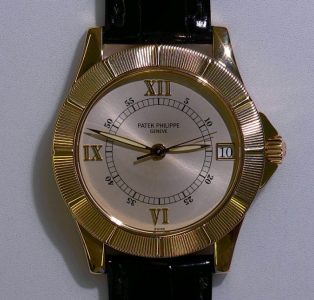As readers may recall, early last year I relinquished two Pateks (5036 & 6006). The former as it was too nice to wear (and a bit of a pain to keep all the complications up to date – even on a winder!) and the latter, in the end, just did not tick all my boxes. So, rather than be imprisoned in my safe, I felt that parole was due. The 6006 was the first to be realised, being reverse part-exchanged with a Lange & Sohne Saxonia Outsize date – as reported on previously. The 5036 was a more tricky issue: I did not want to risk dealing directly with a private buyer, but nor was I looking forward to an offer from a retailer! In the end I decided to try the retailer that I had bought it from – The Watch Centre in Bond St. Well, they were interested – but not in a straight sale, but would consider giving me some cash, if I say bought a cheaper watch from them. Well, this was not entirely what I wanted, but as I still required a Patek in my collection and I had seen a possible candidate in their inventory, maybe something could be worked out!
The watch I espied was a 1997 Neptune 5081J, in yellow gold with a silver dial and on a brown leather buckle strap. I had in fact long-admired this model, plus, it still seemed to be good value when compared to, say, the frankly insane levels of a used Nautilus or Aquanaut! The only initial negatives of this particular watch were the absence of any box or papers – a bit of an issue with me usually.
Anyway, discussions ensued with Rony at TWC, but initially there was an impasse over money. I felt my 5036 was worth at least £35k (what I had paid for it several years before, plus, gold had now shot up), but the maximum cash on offer was £20k. As the Neptune was up at some £13.5k, I would be £1.5 light. Rony was adamant that the maximum cash on the table was £20k, but after some more discussion, and in order to appease me, Rony offered to include a contemporary Patek box. He also mentioned that an archive extract had been applied for and would also be included. In the end I decided to accept as it was the most efficient and possibly fairest deal I could get.
When I got the watch all seemed fine, so I settled down to write an article. Once I got going it became pretty apparent that there was in fact not a lot out there on the Neptune – or at least little of great import. As such I made contact with a watchmaking acquaintance/pal at the Patek boutique in London to elicit more information. After having provided him with the requisite reference/serial numbers, I sat back and waited. After a short period he contacted me with news, which, frankly, was rather disturbing. The serial number actually related to a black dial version, plus, the delicate leaf hands which were “skeletonised” should be filled with lume. Additionally, the watch had lost it’s original deployant strap – something I had pondered at the time but was not actually that concerned over in truth. Needless to say all this was a worry, so I immediately got in touch with Rony, who to be fair, was equally surprised. Moreover, he had just received the archive extract and it noted a “sunburst silvered dial”. Even more mystifying was the statement at the end of the paper; “the above dial is not mentioned in our archives”!
As you may appreciate I was now in some state of a dilemma about what to do. Anyway, I decided to give all this information to my Patek contact who could apparently access additional records. A week or so later, the news came back that the dial had in fact been changed by Patek. However, the hands had been interfered with elsewhere. Patek could reinstate a black dial (and provide a new archive extract to reflect this) and replace the hands. Time for a pause and serious think!
My initial reaction was to reinstate a black dial, replace the hands and have a full service. However, I was also now aware that the watch should have had a black crocodile strap with a gold deployant buckle, instead of the brown strap with a frankly too-small 12 mm buckle – albeit both from Patek. To have all this work done would in fact cost somewhat over £3000 – the gold deployant in particular is very expensive!
I then thought again and reasoned that as I quite liked the silver dial – and that the modification had been done and sanctioned by Patek, maybe that change was not really necessary. Additionally, I was not too bothered about reinstating the deployant strap as, frankly, I sometimes found the round “Calatrava” button a little intrusive, and unlike most other makes, it closes in the opposite direction. This was in fact one aspect of the 6006 I was not overly keen on. Instead, Patek could supply a new 14mm gold buckle (at some £450), and the new black strap in crocodile would actually be included within the service price of some £950. The hands could also be replaced for some £300.
At this juncture I went back to Rony with all this information and my thoughts – which were essentially to respectfully ask for some monetary contribution, as I had effectively been sold something that was not quite as it should have been. The dial was wrong, the strap and buckle were wrong, and the hands were damaged. I did of course explain that some of the rectifications were not going to occur – so the final bill would be rather less, and of course the service and buckle were down to me. In the end Rony made an offer, but, if this was not acceptable, then a full refund would be given. At this point It did occur to me that if I opted for the full refund then effectively my 5036 would have been sold outright – something I was after in the first place!
I then discussed everything again with my Patek mate. In the end I decided to keep the watch and accept Rony’s offer. Why? Well; 1) Despite all the issues, I still really liked the watch, 2) Specifically, I felt the silver dial made the watch a little rarer than the more common black dial version, plus, as it was an official Maison change and had archive supporting paperwork, that all legitimised the watch. 3) The total cost of the service/remedial work would come in at some £1,500, so, with the refund from Rony I could live with that. Incidentally, I personally felt that the Patek costs were actually pretty reasonable, when, say, compared to the estimate I had from Vacheron Constantin to service my 1963 Turn-O-Graph!
Anyway, moving a long a bit, I sent the watch off to Patek via their very efficient door-to-door security guard service. It took a bit longer than I expected (as they were not entirely content on the final testing) – so some 3 months, but that was OK. When I had the watch back (via the same delivery method), well, it was superb!! It came in a nice leather rectangular travel-type pouch and of course the all-important service letter.
So, along with the box and archive extract, I felt the outcome was as near to 100% as was possible to get in the circumstances. My thoughts over TWC? Well, I was naturally none too pleased when the anomalies first came to light. However, I am satisfied that the dial issue was not obvious – especially when the report from Patek emerged. The defective hands a bit less so – as was the strap, and Rony accepted this. Overall however, I feel that TWC behaved in a decent and fair way, so I remain on good terms, and yes, I would buy from them again!!
So, to the review. Well, firstly I would just mention that what ensues is based on my own research – along with information kindly provided by Patek. Anyway, the Neptune range was launched in 1996/97 in both gents and ladies references. Overall, some sixty two references were offered (on a phased basis) – twenty for the former and forty two for the latter. These covered a variety of different case materials (possibly six), dial finishes, and complications.
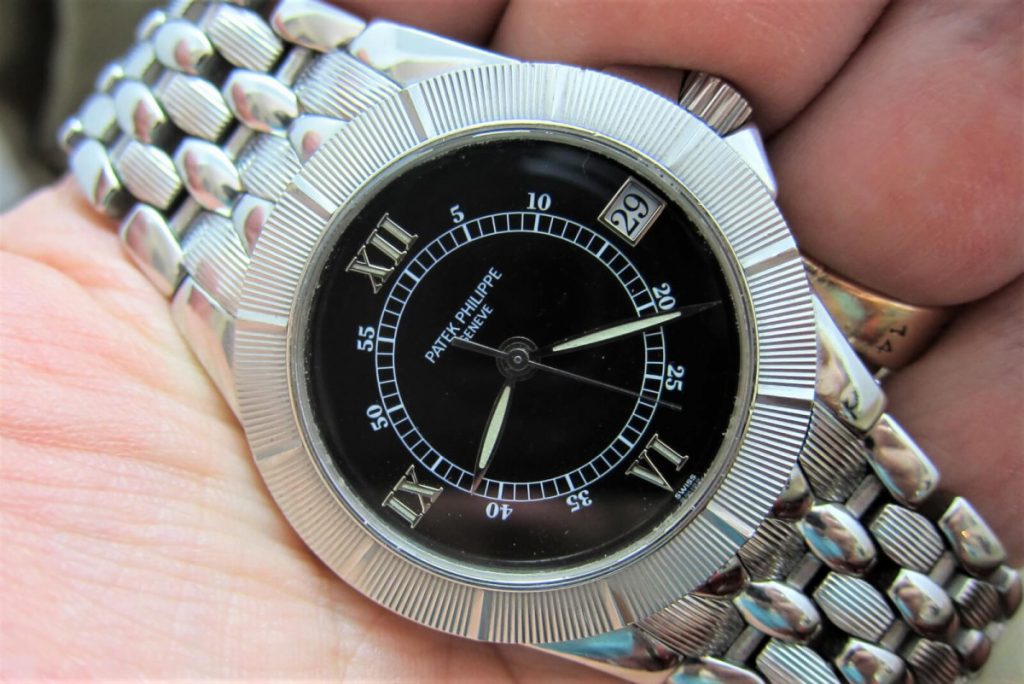
The Neptune was in fact marketed as a crossover sports/dress watch, and of course came somewhat after the Nautilus and a little before the Aquanaut. Initial launch information is a little sketchy, but the very first models (ref 5080) were probably in stainless steel on a bracelet (with the links emulating fish scales) and gold versions followed. The case was 36 mm x 8.11 mm, with a fluted bezel, leaf-shaped hands, date at 3 o’clock, sunburst finished dial (either in silver, black or salmon) and with a single railroad minute track. Roman numerals were employed. The calibre was the 315 SC version, with 29 jewels, Gyromax balance, a solid gold microrotor, vph at 12,600 and power for some 48 hours. Sapphire glass was employed to the front and a solid case back. Water proofing was noted at 60m. This model ceased in 2002.
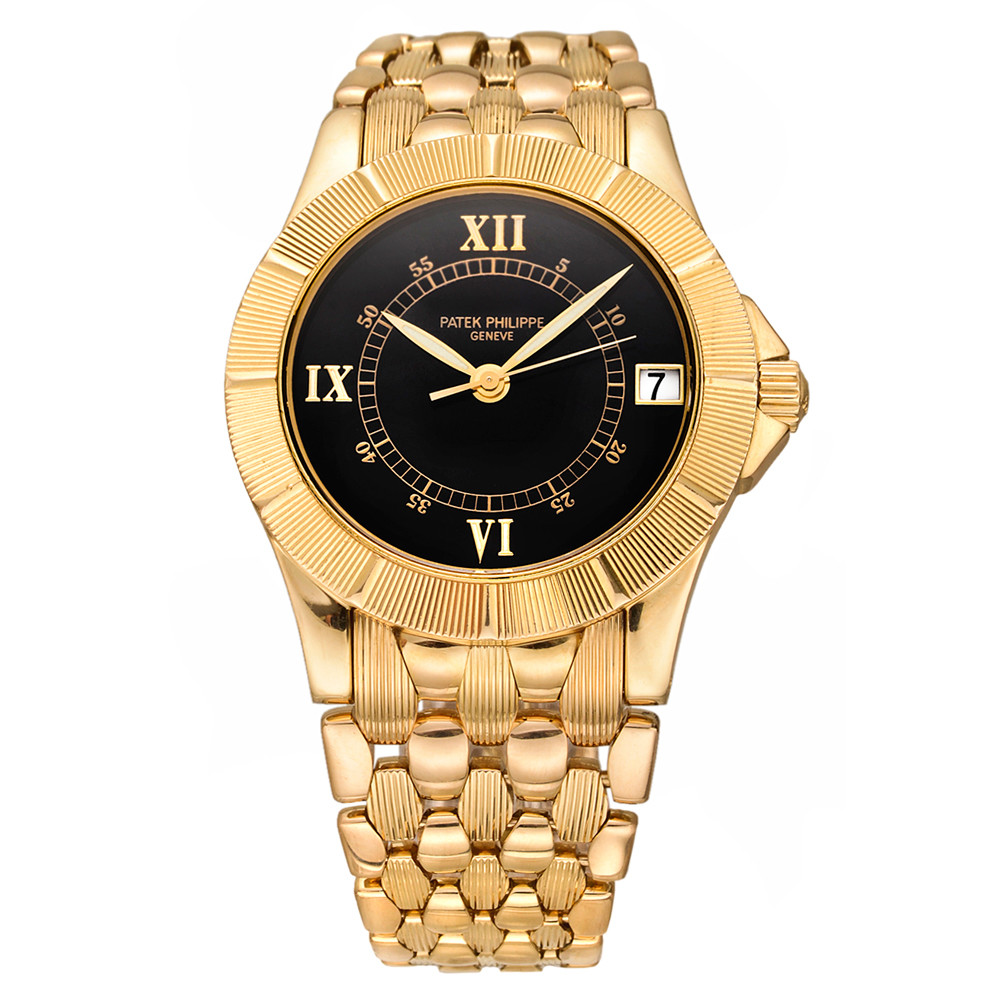
A little after launch, reference 5081 emerged and was essentially the same as 5080, except that it was available on either a bracelet or deployant strap. One really snazzy version sported a diamond bezel and diamond hour markers (5081/10J-001)
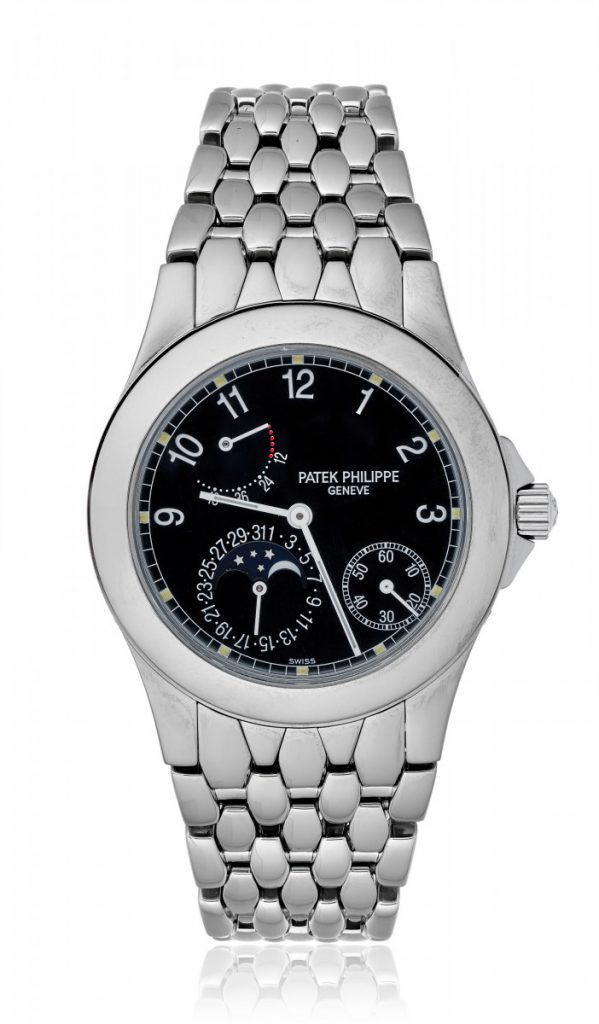
In 1998 reference 5085 appeared and this upped the complications somewhat, including; moon phase, date, and power reserve indicators. The case was now 37 mm but waterproofing went down to 25m. The motive calibre used was 240/164. This model ceased in 2003.
It would seem that the whole model range ceased in 2005, so really did not have a very long lifespan – at least in Patek terms. This may have been due to it’s Nautilus and Aquanaut cousins edging it out.
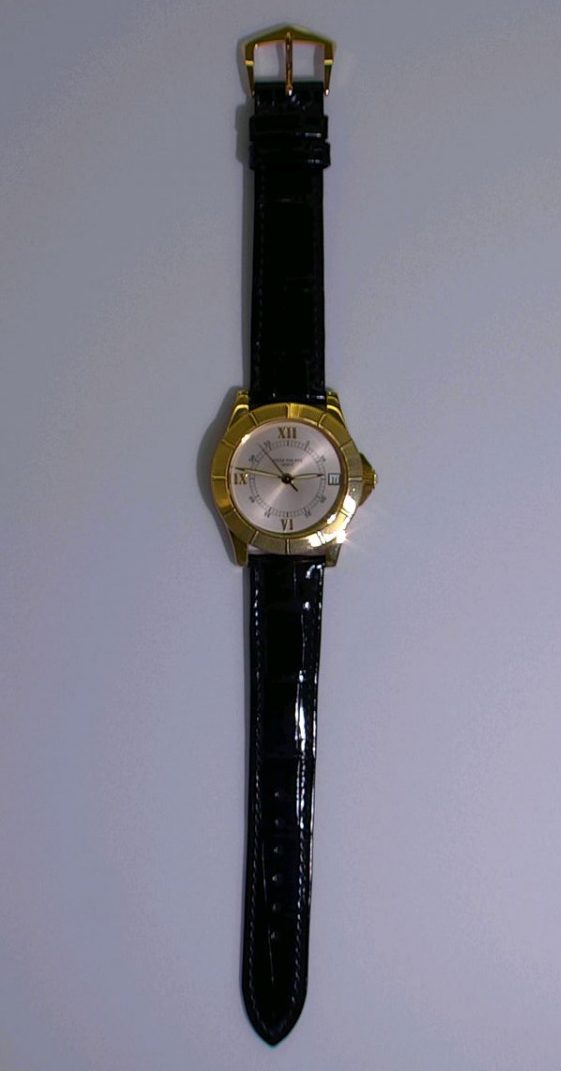
So, to my watch specifically. It is from 1997 and is in yellow gold. The case is 36mm x 8mm, so a decent size, but nicely slim too. The bezel has outward radiating fluting, punctuated at 5 minute intervals by heavier baton markers. All this makes the watch wear a little larger than it’s official 36 mms. The case sides are lightly brushed and the tops of the beautifully tapering lugs (18mm width) are polished. The crown nestles within modest guards – again polished on the upper surfaces and brushed to the sides. The case back is a very simple and solid screwed-in affair.
Turning to “that” dial! The whole disc is one flat plane of silver with a fine sun burst pattern (Sattine). The outer portion contains quite heavily applied Roman numerals in gold at 12, 6 and 9. Number 3 is sacrificed for the gold framed date window containing fine black Arabic numerals on white. There is then an inner rail track with segmented minutes along with Arabic numerals at 5 minute intervals. Next, the hands are gold feuille-shaped (oddly Patek say Pear – but they really are leaf!) infilled (now) with green lume. The second hand is a plain gold needle. That is really it for the dial – fairly simple, but very clear and extremely well-executed. At this point I would say that the black dial versions are also very attractive and, in some ways, shows off the gold a little better. Also, I think that they have lumed Roman numerals too, for some reason.
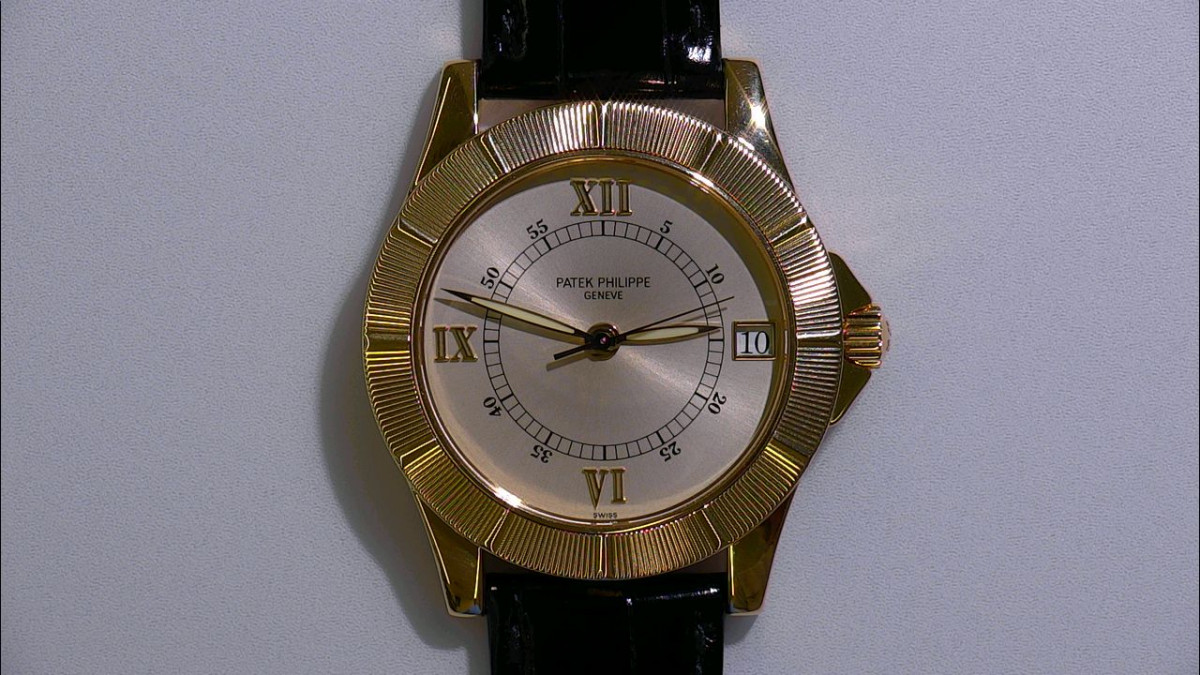
The movement detail has already been noted so I shall not repeat, but interestingly it was also used in the Aquanaut.
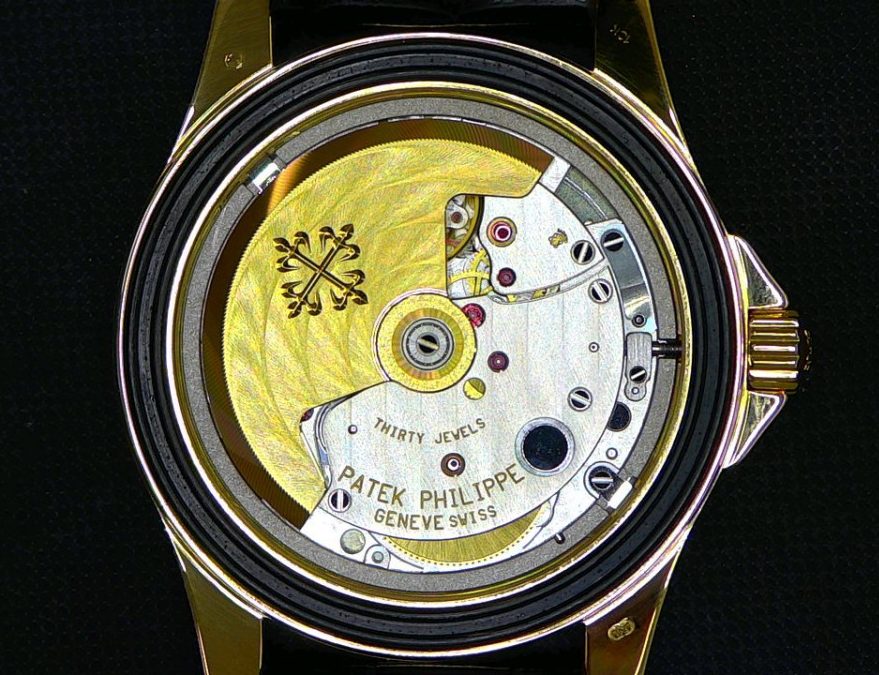
Lastly, the strap. Well, as has been mentioned, when new it would have had a black crocodile gold deployant item. This would have looked good, but for me a simple tang/buckle is just fine. So, mine now has this tapering from 18mm at the lugs to14mm (rather than a tiny 12 mm) with the new buckle. The latter is finished with a slightly triangular buckle – in some ways matching the general shape of the crown and guards I feel. Incidentally, I do concede that a nice brown crocodile strap would also look equally classy – in some ways a little more maybe. But, I just prefer originality!
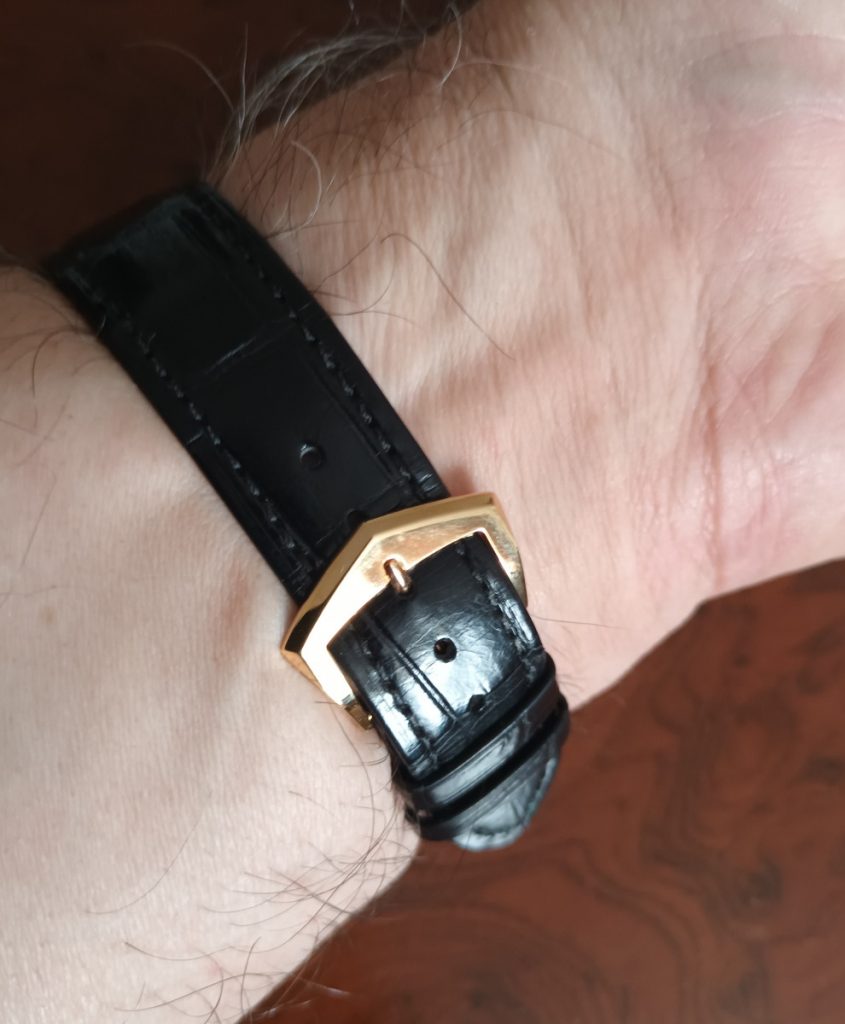
In conclusion: Needless to say I love this watch! It does everything right, and to me really has no negative aspects. It is attractive, easy to read, comfortable to wear, and for high quality does not utterly bust the bank. Despite the earlier rather inauspicious start, I am also very content. Additionally, I feel that this time/date only model was and remains very underrated, and therefore a bit underpriced. I feel it could easily become the new “cult” watch at some point.
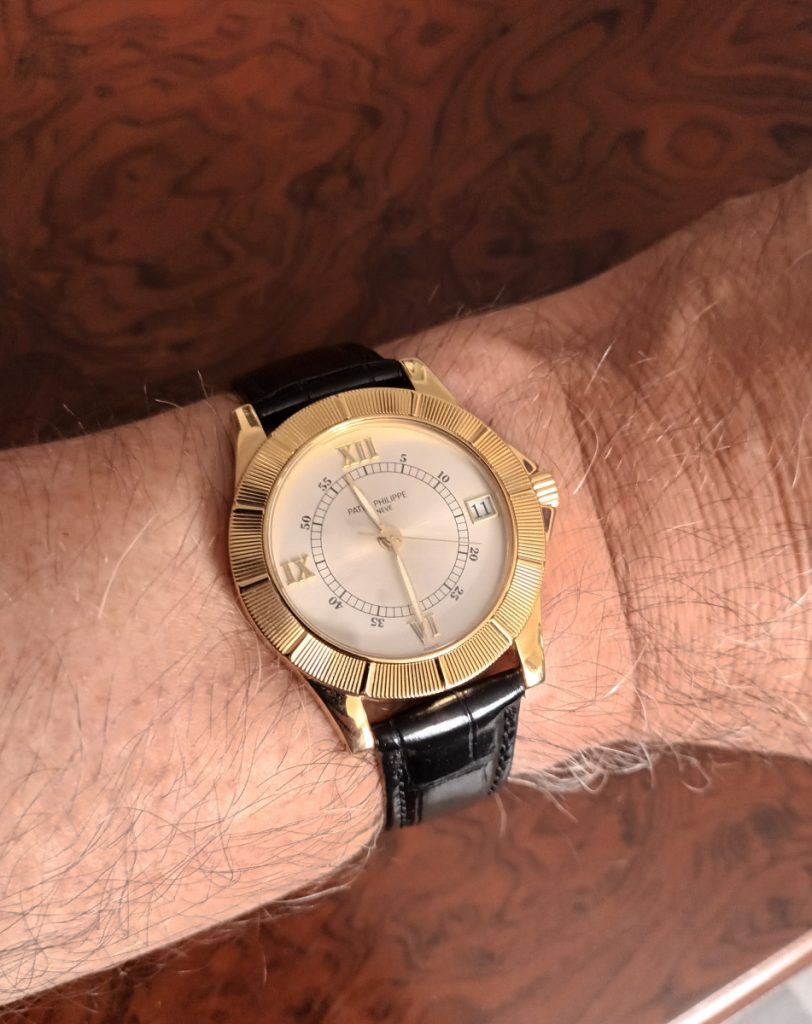
Lastly, did the figures all work out? Well, on checking current prices on, say, Chrono 24, these come in at about £17k+ (some without boxes/provenance and service etc), and so I feel mine is worth at least that that. So, yes, I am OK with my initial outlay! Just one last point: I do think that the gold and black dial version on a gold bracelet is probably the ultimate example of the watch, and if one came up at the right quality and price I could be sorely tempted. They are however pretty rare and seem to go for about £26k or so, which is in fact similar to the 5085 models. So, a bit of saving up will be needed!
Words/The Writer
Images: The Writer and Patek (taken during the service at The Writer’s request).
Much thanks: to Paul Crowley at Patek.

